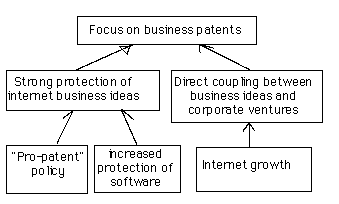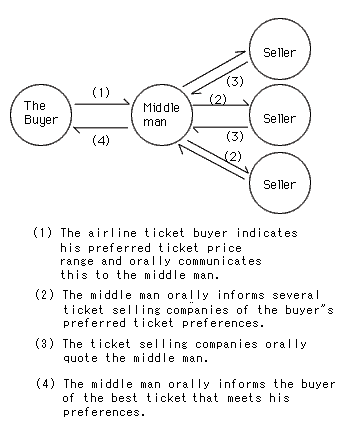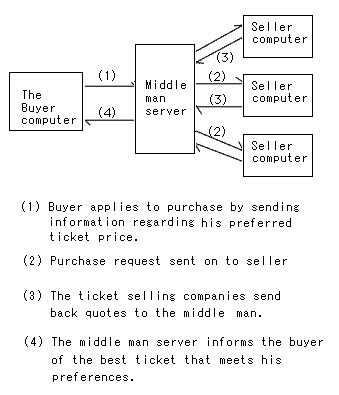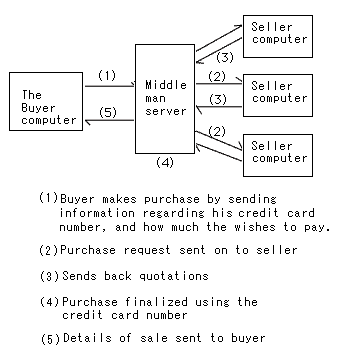|
|
A grounding in business patents (business method patents)
Hideo Furutani, Patent Attoney
2000
A table of contents
1. The Nature of the Business Patent
2. Background to Business Patents
3. Frequently Discussed Aspects of Business Patents
4. Patentability of Business Patents in Japan
5. Patentability of Business Patents in the U S A and in Europe
6. Examples of Business Patents
1. The Nature of the Business Patent
(1) The definition of the business patent
While a variety of expressions including, the "business method
patent", the "business method patent", the "business
model patent" and the "business related patent" are used
to portray the same entity, the term, "business model patent"
predominates in Japan and the term, "business method patent" has
shown ascendancy in the USA.
Irrespectively, here, I would like to define business patents as those patents
which are concerned with business methods and business systems and the like.
Under this definition, the term "business model" would have a
slightly different shade of meaning and therefore inapplicable when used
in connection with management sysytem. Furthermore, when "business
method patents" are referred to, the focus is entirely on method and
so accordingly, this will be the interpretation of the term "business
patent" used in this paper.
(2) Distinguishing Characteristics of the Business Patent
In Japan, although pure business methods themselves are not subject to patent
protection, business methods using the internet and computers can be subjected
to patent control. In the USA (similarly to in Japan and Europe), as was
stated by the Tripartite Director-Generals Meeting in June 2000, pure business
methods that do not have technical aspect are not subject to patent control.
However, many of patent attorney in USA thinks that the pure business methods
are also subject matter of patent law. (see The
Patentability of Business Methods in the name of the United States Group)
Although there has been some novelty in business methods and business systems
themselves, in many cases, the technology upon which they are based is well-known.
In other words, the innovation is in the way in which the technology is
used and in the applications it is used for and so therefore, it could be
said that the actual possibility of establishing rights for business systems
would constitute a distinguishing characteristic of the business patent.
2. Background to Business Patents
For approximately one year now, there has been considerable focus on
business patents and it is an inescapable fact that there have been some
profound changes.
(1) The Industrial Revolution and the First Patent Revolution
The industrial revolution of the 19th century gave birth to mass production
and subsequent thereto, innovation and contrivance in relation to these
products has had considerable effect upon corporate management. In the areas
of machine structure, electrical devices and the like, manufacturing has
been carried on based on information derived from such as mechanical design
drawings and electrical circuitry drawings. Clearly, a time was reached
when the importance of using patents to protect the innovations and contrivances
that embody these mechanical design drawings and electrical circuitry drawings
was recognized. I will refer to this as the first patent revolution.
There was an enormous difference between companies that had production equipment
and a sales infrastructure and those that did not therefore, possession
of patent rights did not determine who was to be the corporate victor.
(2) The Information Revolution and the Second Patent Revolution
The 1950s, one hundred years after the industrial revolution, saw the advent
of the program memorizing computer system, EDSAC. The program was composed
of electronic information and so accordingly, it had the remarkable feature
of being able to easily facilitate product reproduction or mass production.
In the software industry, having the production equipment was not the primary
deciding factor in determining who was to be the corporate victor rather,
it was who had relatively the best idea that decided the outcome. The exponentially
increasing appearance of successful software development companies that
use ideas as combat weapons appeared as an accompaniment to the development
of personal computers.
Additionally, the internet emerged and developed as a system whereby computers
could interact with each other. Also thanks to the internet, the relative
importance of having a sales network to facilitate competitiveness has decreased.
From what formerly used to be the big three factors that influenced corporate
competitiveness, namely; innovative ideas, production equipment and sales
network, innovative ideas has emerged as the most decisive. Irrespective
of the relative size of a company, we are now in an age when companies do
battle over the superiority of ideas. For the very reason that these ideas
can now be protected by patents, their importance as the decisive factor
in the corporate battle has considerably increased. We are clearly in the
middle of the second patent revolution.
(3) Business Patents
Rather than being thought of as a reform of the patent system, this patent
revolution should be preferentially considered as being a transformation
in the value ascribed to the usage of the patent system. The transformation
of the economic and social environment brought about by the information
revolution could be seen as accessories thereto.
Against the backdrop of the second patent revolution, the existence of business
patents is conspicuous, however it is important to be aware that not all
aspects are conspicuous.
It is difficult to predict what the repercussions of these transformations
will be on the legal handling of business patents. However, what is a certainty
is that the information revolution that spawned these transformations will
continue to manifest itself. The focus will not be so much on the ways in
which business patents are handled but rather, the increasing importance
of patents in corporate management. Clearly, the patent revolution will
continue to keep pace with the information revolution.
IT is not the only field to be affected. IT has extended itself throughout
the whole patent spectrum. Using patents to monopolize markets as attempted
in the USA by companies such as IBM and Xerox is not the only angle, they
have also been successfully used as a means to improve corporate cash flow.
Ten years ago, IBM received slightly less than $30 million for license royalties
which became worth $10 billion in 1999. Another case is M&A which is
going from strength to strength by aiming at increasingly more patents to
build up their patent portfolio. We can see, therefore, how the use of patents
in corporate organizations began to undergo dramatic transformations. It
should be noted here that business patents are only examples of the patent
revolution.
3. Frequently Discussed Aspects of Business Patents
Patents relating to business methods were first applied for in the 1980s
and rights were subsequently granted. However, except for people directly
involved with patents, they received very little public attention up to
about 1998. So what are the factors that suddenly led them to receive so
much notoriety despite their having been in existence for so many years
?
The factor directly responsible and that which caused so much reaction was
the ruling handed down by the Court of Appeal Federal Circuit (CAFC) in
USA in July of 1998 concerning The State Street Bank in which it was stated
that business methods were to be regarded as within the jurisdiction covered
by patents. Until then, business method patents had been granted but it
was generally doubted whether the courts could actually enforce the rights
granted thereby. The State Street Bank decision set a precedent that effectively
dispelled these doubts and gave clout to business patents.
One should not ignore the consequences indirectly effected by the aforementioned
patent revolution. This was not a direct factor but rather a background
cause and was composed of two interdependent agents, namely; the consolidated
protection offered to software related inventions involving the "Pro-patent"
policy and; the exponentially increasing spread of the internet. Against
the background of these two factors, The State Street Bank decision paved
the way for the age of business patents.
(1) Consolidated protection offered to software related inventions
Under the "Pro-patent" policy adopted by the Reagan administration
in the 1980s, the range of rights afforded to patents was expanded and indemnity
awards with respect or loss or damage was increased dramatically. In the
early stages of the "Pro-patent" policy, there were a number of
cases in which Japanese camera and game manufacturers received high indemnity
pay outs for patent infringements. This policy lent strength to patent holders'
rights and expanded the protection afforded to software. Indeed in the USA,
software protection has gradually grown increasingly stronger as can be
seen by the following examples: the 1982 Supreme Court's decision in the
Diehr case in which the patenting of software was legally recognized; the
1987 Patent Office examination guidelines reform specifically aimed at the
clarification of software patents and; the 1996 examination guidelines reform
in which the patenting of recording media for recording programs was legally
recognized.
The American "Pro-patent" policy was not confined to protection
strengthening within the USA, TRIPS and WTO was instrumental in calling
for protection strengthening in other countries as well. Likewise, these
trends have spread to Europe and Japan. In Japan, the 1975 examination criteria
for computer program related inventions (No. 1), the 1982 microcomputer
operation guidelines and, the 1993 examination criteria for software related
inventions have enlarged the range of protection that can be afforded to
software related inventions. Following after the USA, subsequent to the
1997 operation guide for examination of software related inventions, the
patenting of recording media for recording programs was legally recognized.
Taking its cue from the IBM case, European Patent Office did not stop at
recognizing recording media but went the extra step in protecting the programs
themselves.
The strengthening of the protection for software patents due to the "Pro-patent"
policy in the USA extended to Japan and Europe.
(2) The exponentially increasing spread of the internet
Prior to the spread of the internet, any innovative ideas concerning a product
or service could only be transformed into company operations by such means
as product prototypes, and the development of new sales channels. The growth
of the internet has enabled the development of sales channels comparatively
to be set up relatively easily and ideas to be directly incorporated into
business workings. Without the infrastructure of the internet, there would
be considerable difficulty in converting ideas into business ventures as
can be seen in the following cases: the Attention Brokerage patent (USP5794210)
owned by the Cyber Gold Inc., disclosing an organization that sells consumer
attention; and the Price Line patent (USP5794207) disclosing an organization
for selling tickets and the like through buyer-driven.
Next to America, the most remarkable growth of the internet has been seen
in Japan and Europe. Just fifteen years ago, setting up new ventures was
a troublesome undertaking. However now, even actualized business ideas which
cannot capture a large section of the market can reach many customers worldwide
due to the structure of the internet, thus enabling many new ventures to
be set up.
(3) The relationship between "Pro-patent" and the internet
As I have explained above, the growth of the internet has facilitated the
direct coupling between business ideas and corporate ventures and, the strong
protection of ideas as software related inventions by virtue of the "Pro-patent"
policy. These two factors have caused business patents to become the center
of attention.

Of course, not all business patents are internet related inventions but
I would like to say that many of those which have been subject to public
acclaim do involve the internet in some measure. Examples include:
Open Market's patents for electronic trading (USP5,724,424; USP5.715.314;
and USP 5,708,780)
Netcentive's bonus gifts marketing (USP5,774,870)
Cyber Gold's Attention Brokerage patent (USP5,794,210)
Price Line's patent (USP5,794,207)
Map advertising method (Mapion Patent) (Japanese patent 2,756,488)
Double Click's web advertising method patent (USP5,948,061)
Amazon. Com's one click patent (USP5,960,411)
WWW scheduling control patent (USP5,960,406)
4. Patentability of Business Patents in Japan
I will now give an account of the types of business models
that are patentable. Generally, the following three requirements have to
be satisfied before a patent is granted:
i) Must be an invention
ii) Must have novelty
iii) Must have inventive step
Even if one of the above is missing, the patent will not
be granted. Accordingly, even if in the case of an innovative idea, if this
idea is not accredited with being an invention, the patent right will not
be granted.
(1) Must be an invention
Japanese Patent law provides a legal framework in which patent
rights are granted to offer protection to inventions. Naturally, if the
item in question is not an invention, a patent cannot be granted. While
in the many fields of technology, there is little incidence of doubt arising
as to whether an idea constitutes an invention or not however, in software
related inventions, principally inventions related to business models, there
are considerably more.
According to article 2 of the Patent Law, an invention is defined
as being a highly creative work generated from technological thought employing
natural laws. Based thereupon, the Japanese Patent Office has made publicly
available their examination guidelines.
and therein is stated the degree in which a software related invention should
be a creative work generated from technological thought employing natural
laws. As business model inventions are considered to be in the same class
as software related inventions, the statements concerning the examination
policies made in the guideline for examination are applicable.
According to these examination policies, ideas that exclusively
use laws other than natural laws should not be considered as being eligible
for patenting. For example, in the case shown below which depicts the middle
man intervening in sales for airline tickets, the laws at work here are
exclusively economic laws and as such, would not be eligible for patenting.

Therefore, as business methods and business systems themselves
are not inventions, the need to investigate their degree of novelty and
inventive step is negated and the patent will not be granted.
However, if computer use is given as a prerequisite in the above case, pursuant
to the operation guidelines for examination, such a system would constitute
an invention. Accordingly, business models that make use of the internet
can be covered by patents.
According to the guidelines, when the information processing equipment (machine) or operational method thereof particularly
suitable for a use purpose is constructed by concrete means in which software and
hardware resources are cooperatively working so as to realize arithmetic operation or
manipulation of information depending on the said use purpose, the said information processing equipment (machine) or operational method
thereof particularly suitable for the use purpose” can be said to be qualified as statutory invention.
The following system in which the internet is used for middle
man sales of airline tickets would be subject to patent protection as an
invention. Although it satisfies the condition of being an invention,
it does not provided novelty and inventive step and as such, could not be
patented.

(2) Novelty
In order to be granted a patent, novelty as well as being an invention is
required. If prior to application, the business model using the internet
is generally known, the patent will be rejected on the grounds that it is
not novel. Caution should be exercised in that if prior to application,
one causes the invention itself to be made public, it would lose its novelty
status.
Pursuant to Article 29 of the Patent Law, occurrence of any of the following
would result in a non-novelty ruling in Japan:
1. Inventions publicly known both in Japan or foreign countries prior to
application (Article 29, Paragraph 1, Item 1 of the Patent Law)
2. Inventions publicly practiced both in Japan or foreign countries prior
to application (Article 29, Paragraph 1, Item 2)
3. Both in Japan or foreign countries, inventions stated in any publication
or inventions that may be publicly used by means of electronic transmission
circuitry (Article 29, Paragraph 1, Item 3)
If the applicant or inventor himself lost status of novelty due to making
a written announcement, Article 30 of the Patent Law provides for exceptional
relief in granting him non-loss of novelty status if he lodges the application
within six months. It is stressed however that excessive reliance on this
provision is dangerous and as a general rule, it is preferable to lodge
the application prior to making announcements.
(3) Inventive step
In order to be granted a patent, it is presupposed that it is an invention,
has novelty and also, that it takes an inventive step. The concept of inventive
step implies a degree of sophistication that would be easily apparent even
to those ordinary skilled in the art.
Even if it is publicly known, a business model would be accredited with
being novel if it uses the internet. However just simply using the internet
does not imply that it is provided with inventive step and a patent would
not be granted. The operation guideline for examination states that use
of a computer to carry out already publicly known human acts does not represent
inventive step. For example, if the pure business model depicted in Fig.
2 were publicly known, it is highly likely that the model depicted in Fig.
3 would be judged as not having sufficient inventive step.
If a business model is enacted using the internet, and if it incorporates
some kind of ingenious contrivance, it is probable that it could boast inventive
step. Naturally, if the model itself is new, it would be provided with inventive
step.
As mentioned above, if the business model shown above in Fig. 2 is publicly
known, then the model shown above in Fig. 3 would be likely to be rejected
on the grounds that it is lacking in inventive step. However as is shown
in Fig. 4, if the web page is set up with a place for insertion of a credit
card number which may be used to purchase one of the sales alternatives
offered by the seller, the Fig. 2 business model would be likely to be seen
as exhibiting inventive step.

5. Patentability of Business Patents in the U S A and in Europe
While I have mentioned patentability in Japan, I have not touched on this
situation existing in the USA and Europe, particularly with respect to the
requirement that it be an invention.
(1) U S A
Unlike in Japan, the way in which computers are used has not been judgment
criteria in America for satisfying the requirements that there must be an
invention and there must be a statutory subject. If the subject of the invention
results in useful and concrete effect, it shall be the object to be granted
patent right, in other words, if it is concrete rather than abstract, and
suitable for practical use, it shall be the object to be granted patent
right. The USPTO has made publicly available their examination guideline
on computer related inventions at the following web sites;
(http://www.uspto.gov/web/offices/pac//dapp/oppd/patoc.htm)
The training material for examiners:
(http://www.uspto.gov/web/offices/pac/compexam/examcomp.htm).
(2) Europe
The European Patent office had decreed that only technological
contributions in a field with respect to prior art, in which patentability
is precluded can be protected. (European patent examination guidelines C-IV2.1-2.2
: http://www.european-patent-office.org/guidlines/english/index.htm).
If this is strictly observed and there is only novelty in business methods,
the status of an invention will not be accorded. Clearly, being granted
a business patent is more difficult in Europe than in either Japan or America.
It should be noted that in the European Patent Office, there had been a
decision on appeal in which the technological contribution had been acceptable
if the prior art had been known from prior arts (Refer to T 1173/97). It
would therefore seem that there has been some relaxation in their policies
and that obtaining business patents will become easier. In addition, the
German patent court made a decision on patent protection for an invention
in which computers are used and it is thought that this will have a measure
of influence on the practices of European Patent Office.
6. Examples of Business Patents
Examples of business patents can be found at my
website under the heading of business patents (Japanese paper).
NOTES
(c)1999 Hideo Furutani. The author is a patent attorney
with the company Furutani Patent Office, Osaka, Japan.
MAIL TO
furutani@furutani.co.jp
To Other english articles
To The Top Page
|